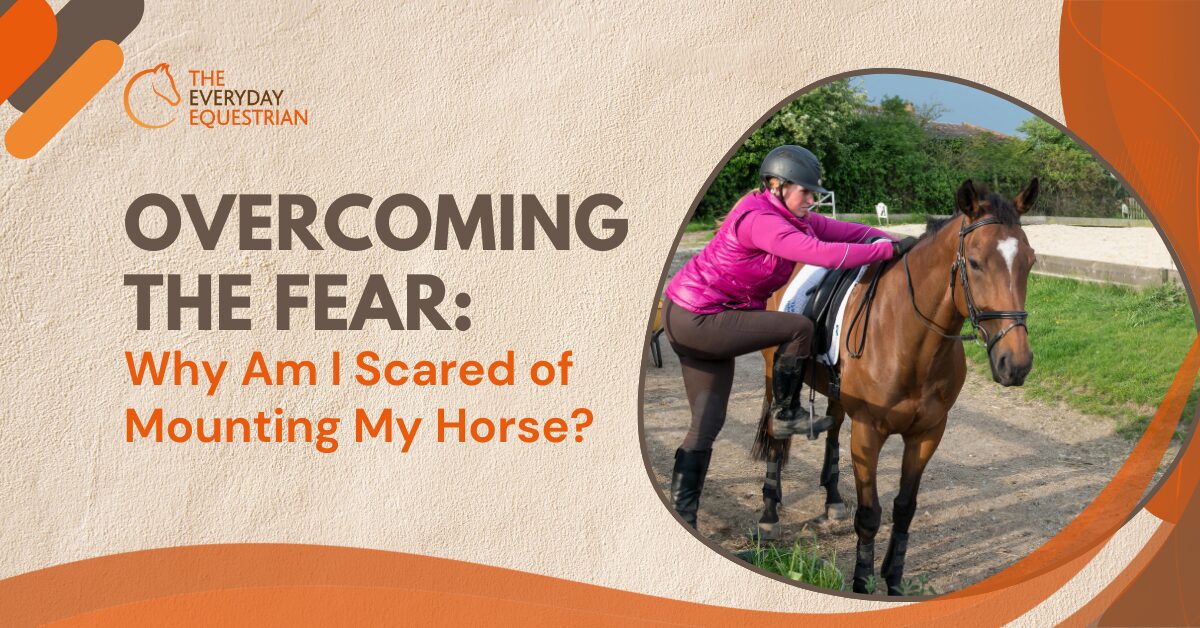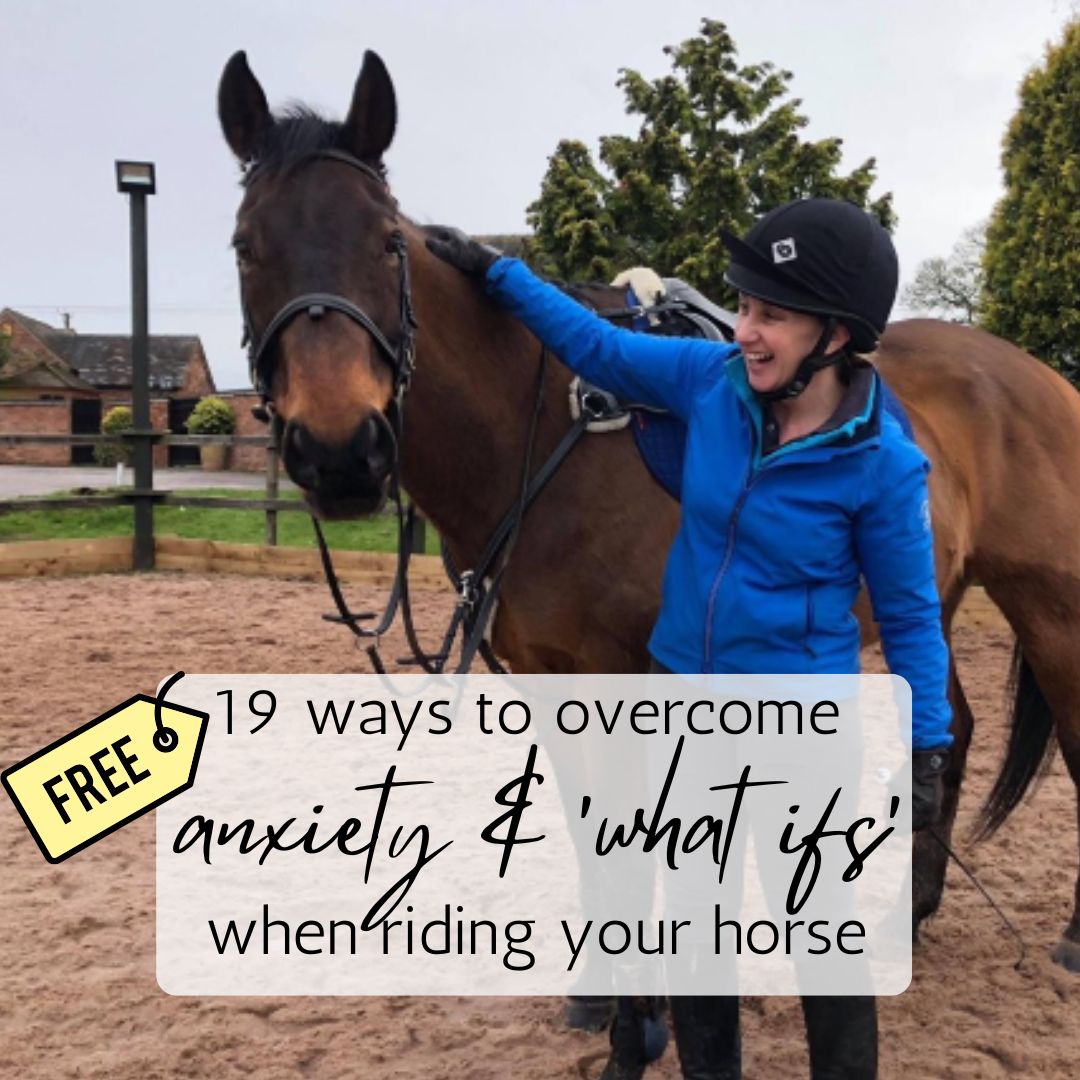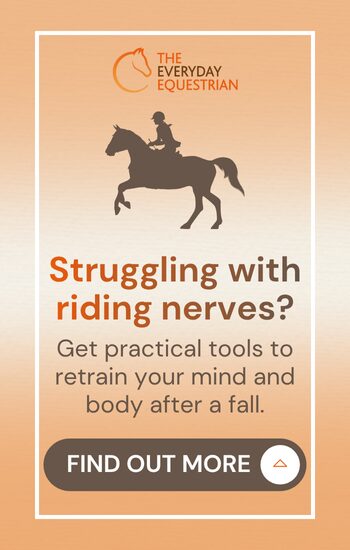Wondering ‘Why am I scared of mounting my horse?’ You’re not alone. Many riders face this fear due to past falls, anxiety, feeling out of control, or simply overthinking in some way. This article will explore these fears and offer practical solutions to help you gain confidence. Understanding different horses‘ behaviours and past experiences is crucial when addressing mounting concerns.
Key Takeaways
- Fear of mounting a horse is common and often rooted in past experiences; understanding this fear is key to managing it.
- Body language significantly impacts both the rider’s and horse’s anxiety levels; staying calm and relaxed helps establish trust.
- Training your horse to stand still and using a mounting block can enhance safety and comfort during the mounting process.
- By working on your psychological skills, mindset, and confidence toolkit, you can overcome anxiety or fear about putting your foot in the stirrup to mount your horse.
- Understanding different horses’ behaviours and past experiences is crucial when addressing mounting fears, as it helps tailor the approach to each horse’s unique needs.
Understanding the Fear
Fear is a natural response, especially when it comes to mounting a horse. Different horses’ past experiences can also contribute to the fear of mounting. The anticipation of something going wrong, such as a fall or injury, can lead to significant anxiety. This fear often stems from our body’s Fight or Flight response, which kicks in when we perceive a threat. Riders may find themselves avoiding or putting off the mounting process, distracting themselves and overthinking it until they can feel like they can’t get on their horse. This anxiety is not uncommon and can be rooted in past experiences or a general anxiety about what might or might not happen.
Understanding that this fear is a normal, human psychological response can be the first step towards managing it. Recognising the triggers and how they make us feel allows us to address them head-on. Acknowledging these feelings will enable us to take steps to reduce anxiety and build confidence. It’s easy to follow a step-by-step process of re-training your brain when you know how!
The Role of Past Experiences
Our past experiences play a significant role in shaping our current fears. Understanding different horses’ past experiences can help in addressing mounting worries. A prior fall or bad experience can create a lasting impact, leading to heightened anxiety and tension when mounting. This tension affects our emotional state, physical state, and breathing patterns, making it even harder to maintain balanced, calm confidence.
Memories of past falls can trigger a protective response, causing riders to become fearful and tense. This rigidity can signal danger to the horse, further complicating the mounting process. Understanding how these past experiences affect us helps us overcome fear and improve riding balance and confidence.
Anxiety and Body Language
Anxiety doesn’t just stay in our minds; it manifests physically through our body. When we’re tense, our horses can quickly pick up on these signals and become anxious themselves. Different horses’ behaviours can influence the rider’s anxiety and body language. This feedback loop of anxiety can make mounting even more challenging. Our body language, including how we distribute our weight and how we breathe, plays a crucial role in maintaining balance and comfort for both us and our horses.
Appreciating the role of body language during mounting is crucial. A calm and relaxed demeanour can help establish trust with your horse, facilitating better communication and a smoother mounting experience. Focusing on your breathing by taking deep, controlled breaths can reduce tension and anxiety, making both you and your horse feel more at ease.
Being mindful of your body language and maintaining calm leads to a more positive and less stressful mounting experience. This approach ensures both you and your horse remain calm and responsive, making the process smoother and more enjoyable.
The Importance of a Calm Horse
Keeping your horse calm is super important when you’re getting ready to mount. The way you approach your horse can really set the tone. If you come in all rushed or aggressive, your horse might get nervous, making it trickier to mount safely. Understanding other horses’ past experiences can help in keeping your horse calm.
Pay attention to your horse’s body language. If you notice any signs of tension, take a moment to reassure them. Make sure your horse stands still before you try to mount—this helps avoid any sudden movements that could startle them.
Don’t forget to praise your horse for staying calm. A relaxed horse is more likely to listen to your cues and stay chill during the whole process. Giving your horse positive reinforcement when they respond well can make a big difference in keeping them calm and cooperative.
Training Your Horse to Stand Still
Training your horse to stand still ensures a safe and stress-free mounting experience, particularly if you’ve had a mounting problem in the past. A relaxed horse is more open to learning and less likely to exhibit spooking or reactive behaviours. Training for relaxation and connection instead of submission creates a safer and more enjoyable riding experience, with the horse standing quietly. Training methods may need to be adjusted based on different horses’ past experiences and behaviours.
Effective training requires your horse’s front feet to be parallel and its back feet positioned under its body. Bending the horse slightly away from the rider can help maintain its balance while standing still. Gradually adding weight to the stirrup while the horse stands still helps the horse get used to the shift in weight.
Groundwork exercises reinforce trust and respect, fostering a clear understanding between you and your horse. Patience, empathy, and adapting training approaches to the horse’s needs and personality are required. These exercises can include leading your horse through obstacles and practising halting.
Using a Mounting Block Correctly
A mounting block can be a game-changer in the mounting process. Using a mounting block instead of mounting from the ground is crucial for the horse’s comfort and balance. It helps distribute weight evenly, reducing pressure on a horse’s spine and withers, preventing chronic pain and long-term injury. Using a mounting block can be particularly helpful for horses with different past experiences.
Mounting blocks offer a safer and more stable way for riders to get on, mainly benefiting shorter riders on taller horses. By minimising the strain, pull and pressure on the horse
Working with a Professional Horse Trainer or Coach
An Equestrian Coach or professional horse trainer can be incredibly beneficial in addressing mounting issues and building confidence. They ensure the horse’s welfare is prioritised, adhering to industry standards regarding care and training methods. Whether you have a young horse or a more experienced horse, a good coach or horse trainer can help you create positive mounting experiences, overcome challenges, fix problems and explore ethical, positive solutions so that you and your horse can progress together.
A professional horse trainer can help address mounting issues related to different horses’ past experiences. They understand the importance of effective communication and technique to ensure a safe and positive mounting process with other horses.
Step-by-Step Guide to Mounting
Before attempting to mount, it’s crucial to check that your equipment, including the saddle and stirrups, is secure and in good condition. Ground exercises, such as exercising the horse or lunging, can bolster a rider’s confidence before mounting. A quick note: if your horse is particularly reactive to a rider mounting, then always get your horse checked by a vet for any signs of pain; horses do not spend their time thinking about how to be difficult or not paying attention in some way! If your horse’s behaviour has changed in some way, or they are showing signs of stress about the mounting process, always rule out pain as a source of their behaviour before implementing any training tactics.
The steps may need adjustment based on different horses’ experiences. Understanding other horses’ behaviour and past experiences can help address mounting problems effectively.
Position yourself at the horse’s shoulder, facing in the same direction to maintain a safe distance and ensure control. To mount from the ground, grasp the reins with your left hand and place your hand on the saddle with your right hand, avoiding pulling the saddle toward you, as this will twist the saddle on the horse’s back and cause discomfort. Place your left foot in the stirrup, and quietly step your weight into the stirrup. Swing your right leg over the horse’s hindquarters (without kicking him!), and sit quietly in the saddle. Of course, using a mounting block is always preferable and will reduce strain on both you and your horse.
Breaking down the mounting process into clear, manageable steps reduces anxiety and ensures a smoother and safer experience. Deliberate, intentional practice makes progress, so pay attention to your technique, remember to breathe and take small steps each and every day to mount quietly, smoothly, calmly and with ease.
Coping Mechanisms for Riders
Relaxation techniques, such as controlled breathing, help riders manage their fear and improve confidence when mounting. Controlled breathing significantly helps riders manage their anxiety and promote relaxation. Techniques like deep breathing exercises, progressive muscle relaxation, and meditation can be incorporated into your pre-mounting routine. These methods help calm the mind and reduce physical tension, making the mounting process smoother and less daunting.
Visualising successful mounting experiences counteracts fear by reinforcing positive memories associated with riding. Visualisation techniques allow riders to rehearse successful performances, reducing anxiety and enhancing confidence mentally. Picturing yourself mounting with ease, feeling confidence and calmness, can create a mental blueprint that guides your actions in real life. This mental practice can be done anywhere, anytime, and it is a powerful tool to build a positive mindset.
Mindfulness techniques encourage riders to focus on physical sensations and the environment during mounting, alleviating anxiety and improving focus. Practices like grounding exercises, where you pay attention to the feel of your feet on the ground or the texture of your horse’s mane, can help keep you present and reduce overthinking. Being mindful of your surroundings and your body’s reactions helps create a balanced state of mind, making the mounting experience more controlled and less stressful.
Building Trust with Your Horse
Building trust with your horse is a critical step in reducing mounting anxiety. Approaching a horse gradually and calmly helps to build trust and reduces nervous reactions during the mounting process.
Calm activities with your horse, such as grooming, reinforce a sense of safety and comfort between you and the horse. A horse standing still at the mounting block fosters trust and confidence between the horse and rider, especially when using a horse stand.
Trust is built over time and requires consistent, positive interactions. Spending time with your horse outside of riding can strengthen your bond. Activities like hand grazing, leading exercises, or simply spending time in the horse’s presence can make a significant difference. Horses are highly intuitive animals and can sense your emotions; being patient and kind helps them feel secure.
Additionally, incorporating groundwork exercises can further enhance trust. These exercises help establish clear communication and respect between you and your horse. For instance, practising leading your horse through various obstacles, asking for halts, and rewarding them for calm behaviour can lay a solid foundation for a trusting relationship. The more your horse trusts you on the ground, the more confident they will feel during the mounting process.
Remember, building trust is a two-way street. As you work on gaining your horse’s trust, you’ll also find your own confidence growing. This mutual trust creates a harmonious partnership, making the ride experience more enjoyable and less stressful for you and your horse.
Small Steps to Progress
Progress often comes in small steps. Setting small, achievable goals helps riders build confidence incrementally, making the riding experience more enjoyable. Repetitive practice of mounting and dismounting reconditions the subconscious, reducing fear through familiarity, often allowing riders to feel as if they are just one foot away from mastering their skills.
By taking these small steps, riders can gradually overcome their fear and build confidence in their mounting abilities.
It’s important to celebrate each small victory along the way. Acknowledging progress, no matter how minor it may seem, helps reinforce positive behaviour and encourages continued effort. For example, if a rider successfully mounts their horse without feeling anxious, they should take a moment to recognise this achievement. This positive reinforcement can boost morale and motivation, making the next attempt even easier.
In addition to setting small goals, riders can benefit from creating a structured practice routine. Consistency is vital in building new habits and overcoming fears. Setting aside regular time for mounting practice can help normalise the process and reduce anxiety over time. This routine can include various exercises to improve balance, coordination, and overall confidence while mounting.
Another effective strategy is to incorporate relaxation techniques into the practice routine. Techniques such as deep breathing, visualisation, and mindfulness can help riders stay calm and focused. Practising these techniques regularly can make them second nature, providing a reliable toolset for managing anxiety during mounting.
Working with a supportive community can also enhance progress. Engaging with fellow riders, joining riding clubs, or participating in group lessons can provide a sense of camaraderie and shared experience. Knowing that others are facing similar challenges can be comforting and encouraging. Feedback and support from peers and instructors can also offer valuable insights and boost confidence.
Ultimately, overcoming the fear of mounting a horse is a journey that requires patience, persistence, and a positive mindset. By breaking down the process into manageable steps, celebrating progress, and utilising effective strategies, riders can build the confidence to mount their horses easily and enjoy a fulfilling riding experience.
Summary
Overcoming the fear of mounting a horse is a journey that involves understanding the root causes, addressing past experiences, and employing practical techniques. From ensuring your horse is calm to using a mounting block correctly, each step is designed to build your confidence and improve your riding experience.
Remember, patience and consistency are key. Taking small steps and working with professionals can conquer your fear and enjoy a fulfilling riding journey.
So, if you’ve been struggling with nerves or anxiety when mounting your horse, you can get access to my exclusive Mounting with Confidence resource in my Crack the Confidence Code community – get all the details right here!
Frequently Asked Questions
Why am I scared of mounting my horse?
It’s completely normal to feel scared about mounting your horse; many people share that feeling due to past experiences or worries about getting hurt. Acknowledging your fear can help you find ways to build your confidence step by step.
How can past experiences affect my fear of mounting?
Your past experiences, especially memories of falls, can create a protective instinct that makes you feel more tense and fearful when mounting. Acknowledging these feelings can help you take gradual steps to overcome that fear.
What role does body language play in mounting a horse?
Body language plays a vital role in mounting a horse, as it can significantly influence both your confidence and the horse’s comfort. A calm and confident demeanour helps reduce anxiety for both you and the horse.
How can a mounting block help in reducing mounting anxiety?
Using a mounting block can really ease mounting anxiety by distributing your weight more evenly across the horse’s back, reducing discomfort and making the whole experience smoother for both of you. It’s a simple tool that can make a big difference!
Why should I consider working with a professional horse trainer?
Working with a professional horse trainer can really help you overcome fears and boost your riding confidence with personalised strategies. It’s a great investment in your skills and safety!



